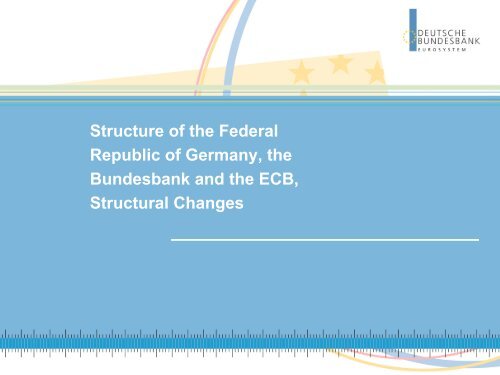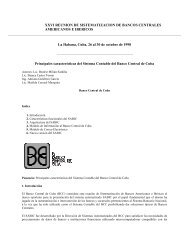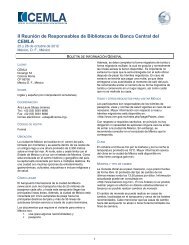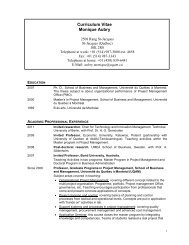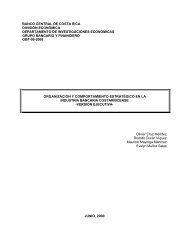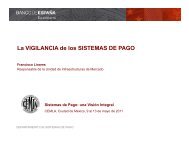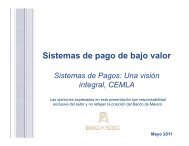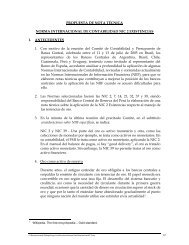Structure of the Federal Republic of Germany, the Bundesbank and ...
Structure of the Federal Republic of Germany, the Bundesbank and ...
Structure of the Federal Republic of Germany, the Bundesbank and ...
You also want an ePaper? Increase the reach of your titles
YUMPU automatically turns print PDFs into web optimized ePapers that Google loves.
<strong>Structure</strong> <strong>of</strong> <strong>the</strong> <strong>Federal</strong><br />
<strong>Republic</strong> <strong>of</strong> <strong>Germany</strong>, <strong>the</strong><br />
<strong>Bundesbank</strong> <strong>and</strong> <strong>the</strong> ECB,<br />
Structural Changes
<strong>Structure</strong> <strong>of</strong> <strong>the</strong> <strong>Federal</strong><br />
<strong>Republic</strong> <strong>of</strong> <strong>Germany</strong><br />
� federation (Bund) <strong>of</strong><br />
16 states (Länder)<br />
� capital: Berlin<br />
� 82.4 m inhabitants<br />
� smallest state:<br />
– Free <strong>and</strong> hanseatic city <strong>of</strong><br />
Bremen (0.6 m inhabitants)<br />
� biggest state:<br />
– North Rhine-Westfalia (18.1<br />
m inhabitants)<br />
� EU founding member<br />
2
<strong>Structure</strong> <strong>of</strong> <strong>the</strong> <strong>Federal</strong><br />
<strong>Republic</strong> <strong>of</strong> <strong>Germany</strong><br />
� federal government<br />
– elected by <strong>the</strong> lower<br />
house (Bundestag)<br />
– lead by <strong>the</strong> chancellor<br />
� 16 governments <strong>of</strong> <strong>the</strong><br />
Länder<br />
– elected by parliaments<br />
(L<strong>and</strong>tag) <strong>of</strong> <strong>the</strong> Länder<br />
– lead by 16 prime<br />
ministers<br />
3
<strong>Structure</strong> <strong>of</strong> <strong>the</strong> <strong>Federal</strong><br />
<strong>Republic</strong> <strong>of</strong> <strong>Germany</strong><br />
� President <strong>of</strong> <strong>the</strong> <strong>Federal</strong><br />
<strong>Republic</strong> <strong>of</strong> <strong>Germany</strong><br />
– Elected by members <strong>of</strong> <strong>the</strong><br />
lower house <strong>and</strong> <strong>the</strong> same<br />
number <strong>of</strong> delegates chosen by<br />
<strong>the</strong> governments <strong>of</strong> <strong>the</strong> member<br />
states<br />
– Representative tasks, such as<br />
appointment <strong>of</strong> ministers or <strong>of</strong><br />
<strong>the</strong> president <strong>of</strong> <strong>the</strong> Deutsche<br />
<strong>Bundesbank</strong><br />
� Most legal acts have to be<br />
adopted by both houses<br />
<strong>of</strong> parliament (�<br />
<strong>Bundesbank</strong> Act)<br />
4
<strong>Structure</strong> <strong>of</strong> <strong>the</strong><br />
Deutsche <strong>Bundesbank</strong><br />
� founded 1957<br />
� public institution<br />
� History<br />
� Independent <strong>of</strong> government<br />
<strong>and</strong> parliament (operational,<br />
institutional, financial <strong>and</strong><br />
personnel)<br />
� Budgetary auditing by <strong>the</strong><br />
<strong>Federal</strong> Court <strong>of</strong> Auditors<br />
� First major organisational<br />
adjustment after German<br />
reunification (1992)<br />
5
<strong>Structure</strong> <strong>of</strong> <strong>the</strong> Deutsche<br />
<strong>Bundesbank</strong><br />
“Old”<br />
<strong>Bundesbank</strong><br />
(before 2002)<br />
9 Presidents<br />
(executive executive (executiveboards) boards boards)<br />
9 L<strong>and</strong> L<strong>and</strong> Central<br />
Banks<br />
Banks<br />
66 66 branches<br />
63 63 sub-branches<br />
sub sub-branches branches<br />
Central Bank Bank Council<br />
Directorate<br />
Central Office<br />
Office<br />
6
<strong>Structure</strong> <strong>of</strong> <strong>the</strong> Deutsche <strong>Bundesbank</strong><br />
Governing bodies until 1 May 2002<br />
Central Bank Council<br />
•President <strong>of</strong> <strong>the</strong> Deutsche<br />
<strong>Bundesbank</strong><br />
•Vice-President <strong>of</strong> <strong>the</strong><br />
Deutsche <strong>Bundesbank</strong><br />
•Remaining members <strong>of</strong> <strong>the</strong><br />
directorate<br />
•Presidents <strong>of</strong> <strong>the</strong> nine L<strong>and</strong><br />
Central Banks<br />
Directorate<br />
•President <strong>of</strong> <strong>the</strong> Deutsche<br />
<strong>Bundesbank</strong><br />
•Vice-President <strong>of</strong> <strong>the</strong> Deutsche<br />
<strong>Bundesbank</strong><br />
•4-6 o<strong>the</strong>r members<br />
Executive Boards <strong>of</strong> <strong>the</strong><br />
L<strong>and</strong> Central Banks<br />
•Presidents <strong>of</strong> <strong>the</strong> 9 L<strong>and</strong><br />
Central Banks<br />
•Vice-President <strong>of</strong> <strong>the</strong> 9 L<strong>and</strong><br />
Central Banks<br />
•If existing, one more member<br />
<strong>of</strong> <strong>the</strong> Executive Board<br />
7
<strong>Structure</strong> <strong>of</strong> <strong>the</strong> <strong>Bundesbank</strong><br />
� Central Bank Council was (until 1.1.1999) responsible for<br />
monetary policy <strong>of</strong> <strong>the</strong> D-Mark (DM)<br />
� The members <strong>of</strong> <strong>the</strong> Directorate were nominated by <strong>the</strong> <strong>Federal</strong><br />
Government, whereas <strong>the</strong> presidents <strong>of</strong> <strong>the</strong> L<strong>and</strong> Central Banks<br />
were nominated by <strong>the</strong> upper or second house (Bundesrat)<br />
which represents <strong>the</strong> <strong>Federal</strong> States (Länder); all were<br />
appointed by <strong>the</strong> Präsident <strong>of</strong> <strong>the</strong> <strong>Federal</strong> <strong>Republic</strong> <strong>of</strong> <strong>Germany</strong>.<br />
� L<strong>and</strong> Central Banks with autonomous competencies in internal<br />
matters (administration, organisation <strong>and</strong> HRM)<br />
8
The three Stages <strong>of</strong> European Monetary Union<br />
1990 - 1999<br />
Stage 1<br />
1 July 1990<br />
• Free movement <strong>of</strong><br />
capital<br />
• Closer co-operation<br />
between NCBs<br />
• Statutes <strong>of</strong> <strong>the</strong><br />
ESCB, ECB <strong>and</strong> EMI<br />
Stage 2<br />
1 January 1994<br />
• Establishment <strong>of</strong> <strong>the</strong><br />
European Monetary<br />
Institute (EMI)<br />
- Co-ordination <strong>of</strong><br />
national monetary<br />
policies<br />
- Preparation <strong>of</strong><br />
Stage 3<br />
• Statutory independence<br />
<strong>of</strong> <strong>the</strong> NCBs<br />
Stage 3<br />
1 January 1999<br />
• Conversion rates<br />
irrevocably fixed<br />
• Single monetary<br />
policy<br />
• Changeover to <strong>the</strong><br />
euro as sole legal<br />
tender from 1.1.2002<br />
9
The ESCB <strong>and</strong> <strong>the</strong> Eurosystem<br />
European System <strong>of</strong> Central<br />
Banks<br />
� founded in 1999<br />
� consists <strong>of</strong> all 27 EU<br />
member states<br />
Eurosystem<br />
� consists <strong>of</strong> 16 EU member<br />
states, which have<br />
introduced <strong>the</strong> Euro<br />
10
The ESCB <strong>and</strong> <strong>the</strong> Eurosystem<br />
ESCB’s Governing Council<br />
� Governors <strong>of</strong> <strong>the</strong> Eurosystem CBs<br />
� members <strong>of</strong> <strong>the</strong> ECB’s Executive<br />
Board<br />
ECB’s Executive Board<br />
� President<br />
� Vice-President<br />
� 4 additional members<br />
General Council<br />
� Governors <strong>of</strong> all EU CBs<br />
� members <strong>of</strong> <strong>the</strong> ECB’s Executive<br />
Board<br />
11
Decision Making Bodies <strong>of</strong> <strong>the</strong> ECB<br />
According to Art. 107(3) <strong>of</strong> <strong>the</strong> EC Treaty, <strong>the</strong>y are:<br />
Governing Council<br />
Executive Board<br />
Governors <strong>of</strong> <strong>the</strong><br />
participating NCBs<br />
(16 at present) Tasks<br />
•formulates <strong>the</strong> monetary policy <strong>of</strong><br />
<strong>the</strong> euro area<br />
•adopts guidelines <strong>and</strong> takes<br />
decisions necessary to perform<br />
<strong>the</strong> entrusted tasks<br />
•consultative function as laid down<br />
in Art. 105(4) <strong>of</strong> <strong>the</strong> EC Treaty<br />
(examples)<br />
Delegation <strong>of</strong><br />
powers<br />
possible<br />
Executive Board<br />
President <strong>and</strong> Vice-<br />
President<br />
4 o<strong>the</strong>r members<br />
•is responsible for <strong>the</strong> day-to-day<br />
business <strong>of</strong> <strong>the</strong> ECB<br />
•implements <strong>the</strong> monetary policy<br />
guidelines laid down by <strong>the</strong><br />
Governing Council<br />
•prepares <strong>the</strong> meetings <strong>of</strong> <strong>the</strong><br />
Governing Council<br />
12
Necessity for changes in <strong>the</strong> <strong>Bundesbank</strong> ?<br />
Reasons for structural Reform?<br />
� 1 January 1999: <strong>Bundesbank</strong>‘s tasks <strong>and</strong> activities in <strong>the</strong> field <strong>of</strong><br />
monetary policy changed radically with start <strong>of</strong> stage three <strong>of</strong> Economic<br />
<strong>and</strong> Monetary Union<br />
� Integral part <strong>of</strong> <strong>the</strong> European System <strong>of</strong> Central Banks (ESCB)<br />
� Joint responsibility for ensuring <strong>the</strong> stability <strong>of</strong> <strong>the</strong> euro within <strong>the</strong><br />
Eurosystem<br />
Necessity to change <strong>the</strong> <strong>Bundesbank</strong>‘s organisation structure<br />
13
Seventh Act amending <strong>the</strong> <strong>Bundesbank</strong> Act<br />
New Law<br />
� Entry into force on 30 April 2002<br />
� Logical consequence <strong>of</strong> <strong>the</strong> transfer <strong>of</strong> monetary<br />
policy responsibility to <strong>the</strong> ESCB/Eurosystem<br />
� Introducing changes in <strong>the</strong> Bank‘s management <strong>and</strong><br />
decision-making structure<br />
14
First strategic cycle 2002-2007<br />
“structural reform”<br />
- Key Elements <strong>of</strong> Reorganisation -<br />
Consolidation<br />
<strong>of</strong> <strong>the</strong> range <strong>of</strong> services<br />
Reorganisation<br />
<strong>of</strong> <strong>the</strong><br />
management levels<br />
Organisational streamlining <strong>and</strong><br />
restructuring <strong>of</strong> tasks<br />
Branch Strategy<br />
Streamlining <strong>the</strong><br />
branch network<br />
15
Important Changes<br />
� Replacement <strong>of</strong> <strong>the</strong> former governing bodies (Central Bank<br />
Council, Directorate <strong>and</strong> executive boards <strong>of</strong> <strong>the</strong> L<strong>and</strong> Central<br />
Banks) by <strong>the</strong> eight-member Executive Board<br />
� Abolishment <strong>of</strong> decision-making prerogatives <strong>of</strong> <strong>the</strong> L<strong>and</strong> Central<br />
Banks<br />
� The existing organisational units - nine L<strong>and</strong> Central Banks <strong>and</strong><br />
<strong>the</strong> Central Office - were merged to form a single entity<br />
� Replacement <strong>of</strong> <strong>the</strong> „L<strong>and</strong> Central Banks“ by „Regional Offices“<br />
� Reporting line via <strong>the</strong> central <strong>of</strong>fice departments<br />
16
<strong>Structure</strong> <strong>of</strong> <strong>the</strong> new <strong>Bundesbank</strong><br />
“New” <strong>Bundesbank</strong><br />
(2003)<br />
Executive Board<br />
Board<br />
(8 (8 members) members members)<br />
Central Office Office with<br />
with<br />
14 14 departments<br />
9 Regional Offices<br />
66 66 branches<br />
34 34 operating units<br />
units<br />
21 21 Service Centres<br />
17
<strong>Bundesbank</strong>´s new “Management Board”<br />
Executive Board (Vorst<strong>and</strong>) in 2003:<br />
� The governing body <strong>of</strong> <strong>the</strong> Deutsche <strong>Bundesbank</strong><br />
� Consists <strong>of</strong> eight members: <strong>the</strong> President, <strong>the</strong> Vice-President <strong>and</strong> six<br />
o<strong>the</strong>r members<br />
� The President, <strong>the</strong> Vice-President <strong>and</strong> two o<strong>the</strong>r members are<br />
nominated by <strong>the</strong> <strong>Federal</strong> Government<br />
� The o<strong>the</strong>r four members are nominated by <strong>the</strong> Bundesrat in agreement<br />
with <strong>the</strong> <strong>Federal</strong> Government<br />
� Members are appointed by <strong>the</strong> President <strong>of</strong> <strong>the</strong> <strong>Federal</strong> <strong>Republic</strong> <strong>of</strong><br />
<strong>Germany</strong><br />
18
<strong>Structure</strong> <strong>of</strong> <strong>the</strong> new <strong>Bundesbank</strong><br />
Current<br />
organisation chart<br />
<strong>Bundesbank</strong><br />
(2010)<br />
Executive Board<br />
Board<br />
(6 (6 members)<br />
Central Office Office with<br />
with<br />
14 14 departments *<br />
*<br />
9 Regional Offices<br />
47 47 Branches**<br />
Branches Branches** **<br />
+ 1 operating unit<br />
unit<br />
* restructuring <strong>of</strong> Departments <strong>and</strong> Divisions has started<br />
** Since end <strong>of</strong> September 2007<br />
18 18 Service Centres<br />
19
Distribution <strong>of</strong> tasks between ...<br />
Central Office, eg Regional Offices<br />
� Management <strong>of</strong> <strong>the</strong><br />
Bank<br />
� Principle tasks<br />
� Regional tasks, eg<br />
� Banking supervision<br />
Branches<br />
� Operational tasks, eg<br />
� Cash/cashless<br />
payments<br />
� Account keeping<br />
20
� OrgaplanZentrale__Englisch,property=publicationFile.pdf<br />
21
Regional Offices<br />
� Uniformly structured Regional Offices<br />
In-house operations<br />
Banking Supervision<br />
Banking Operations<br />
Präsident <strong>of</strong> <strong>the</strong> Regional<br />
Office<br />
Servicecentre<br />
� Set up <strong>of</strong> Service Centres which concentrate at a single location<br />
<strong>the</strong> execution <strong>of</strong> specific Bank-wide tasks. (e.g. securities<br />
settlement <strong>and</strong> deposit account management; procurement)<br />
22
Service Centres<br />
Service Center Regional Office Responsible Central Department<br />
External Sector Audits <strong>and</strong> Reporting Queries<br />
Düsseldorf, Hannover,<br />
Mainz, München<br />
Statistics<br />
External Sector Statistics Mainz Statistics<br />
Automation <strong>of</strong> Banknote <strong>and</strong> Coin Processing München Cash<br />
Cash Management Logistics Mainz Cash<br />
Health Care Subsidies Berlin HR<br />
Damaged Banknotes <strong>and</strong> Coins Mainz Cash<br />
Procurement Frankfurt Since 5.2010 integral part <strong>of</strong> department ‘Administration + Premises’<br />
Administrative Accounting, Asset Accounting <strong>and</strong> Master Data<br />
Administration<br />
Hamburg Controlling<br />
Employees Loans Berlin HR<br />
Cost Accounting Data Processing Hamburg Controlling<br />
Housing Administration Stuttgart Administration<br />
Organisational Analysis *) Düsseldorf Since 5.2010 integral part <strong>of</strong> department ‘Controlling, Accounting …)<br />
Travel <strong>and</strong> Relocation Expenses Berlin HR<br />
Monetary Policy Procedure Projects Hannover Markets<br />
Credit Operations *) Frankfurt Since 5.2010 integral part <strong>of</strong> department ‘Markets’<br />
Financial Sanctions München Legal<br />
Securities Settlements <strong>and</strong> Safe Custody Frankfurt Payment Systems<br />
Computer Center <strong>and</strong> Retail Payment Systems Operations Düsseldorf Payment Systems<br />
23
Branches<br />
� Branches <strong>of</strong> <strong>the</strong> Deutsche <strong>Bundesbank</strong><br />
� The branches are subordinate to <strong>the</strong> Regional Office responsible for <strong>the</strong>ir region.<br />
� They supply banks <strong>and</strong> public authorities with euro banknotes <strong>and</strong> coins. They also<br />
process <strong>the</strong>ir cashless payments <strong>and</strong> provide local credit institutions with direct<br />
access to central bank credit.<br />
� The Branches <strong>of</strong>fer private customers <strong>the</strong> opportunity to exchange D-Mark<br />
banknotes <strong>and</strong> coins free-<strong>of</strong>-charge <strong>and</strong> with no fixed deadline.<br />
24
Adjustment <strong>of</strong> <strong>the</strong> Branch Network<br />
Some Facts<br />
� Switch to a single-tier branch structure<br />
� Examination for each location whe<strong>the</strong>r continued operation as a<br />
branch was commercially viable<br />
� Fur<strong>the</strong>r streamlining <strong>of</strong> <strong>the</strong> branch network<br />
� Nationwide provision <strong>of</strong> central bank services (mainly cash)<br />
ensured by remaining 47 branches<br />
25
Results <strong>of</strong> structural reform:<br />
consolidation process <strong>of</strong> branches<br />
120<br />
90<br />
60<br />
30<br />
0<br />
Number <strong>of</strong> branches <strong>and</strong> operating units<br />
127<br />
end<br />
2001<br />
118<br />
end<br />
2002<br />
100<br />
end<br />
2003<br />
86<br />
end<br />
2004<br />
78<br />
end<br />
2005<br />
71<br />
end<br />
2006<br />
since Sept. 2007:<br />
47 branches +<br />
1 operating unit<br />
48<br />
end<br />
2007<br />
26
<strong>Bundesbank</strong> locations before <strong>the</strong> structural reform in 2002<br />
27
<strong>Bundesbank</strong> locations today<br />
28
Streamlining <strong>the</strong> Range <strong>of</strong> Cash Operation Services<br />
Reaction <strong>of</strong> Changes in <strong>the</strong> Cash Cycle<br />
Backgrounds:<br />
� Increasing involvement <strong>of</strong> <strong>the</strong> <strong>Bundesbank</strong> in cash h<strong>and</strong>ling <strong>and</strong> processing<br />
operations for <strong>the</strong> last years<br />
� Review <strong>of</strong> <strong>the</strong> <strong>Bundesbank</strong>‘s role in cash operations<br />
Result:<br />
� Reorientation <strong>of</strong> business policy in <strong>the</strong> field <strong>of</strong> cash-related transactions<br />
(wholesaler not retailer)<br />
� General principle: free <strong>of</strong> charge supply <strong>of</strong> those cash operations which are<br />
defined as st<strong>and</strong>ard service portfolio in <strong>the</strong> Eurosystem<br />
� Ongoing participation in banknote-processing for <strong>the</strong> sake <strong>of</strong> assuring <strong>the</strong><br />
present quality st<strong>and</strong>ard<br />
29
Branch Strategy 2012/ 2015<br />
�Close <strong>of</strong> 12 Branches<br />
until 2015<br />
�Planning <strong>and</strong> building a<br />
new Branch (Cash Centre)<br />
in <strong>the</strong> Rhein-Ruhr-Region<br />
which should replace<br />
ano<strong>the</strong>r 5 existing<br />
Branches<br />
�<br />
Oldenburg<br />
� Osnabrück<br />
Bielefeld<br />
�<br />
Hannover<br />
�<br />
Berlin<br />
�<br />
Göttingen<br />
Dortmund<br />
Essen<br />
� �Bochum Hagen<br />
� � Leipzig<br />
�Köln<br />
�<br />
Erfurt<br />
�<br />
Chemnitz<br />
�<br />
�<br />
�<br />
Düsseldorf<br />
Koblenz<br />
�<br />
Frankfurt<br />
Mainz�<br />
�<br />
Ludwigshafen�<br />
�<br />
Saarbrücken<br />
�<br />
Karlsruhe Stuttgart<br />
�<br />
�<br />
Reutlingen �<br />
Villingen-<br />
Ulm<br />
Schwenningen�<br />
�<br />
Freiburg<br />
Hamburg<br />
�<br />
Würzburg<br />
�<br />
�<br />
Augsburg<br />
Magdeburg<br />
�<br />
Nürnberg<br />
�<br />
�Rostock<br />
�<br />
Neubr<strong>and</strong>enburg<br />
München<br />
�<br />
�<br />
Regensburg<br />
30
Branch Strategy 2012/ 2015<br />
120<br />
90<br />
60<br />
30<br />
0<br />
118<br />
Branches at <strong>the</strong> end <strong>of</strong> 2015<br />
86<br />
48<br />
Ende 2002 Ende 2004 Ende 2007 Ende 2012 Ende 2015<br />
41<br />
35<br />
31
Results <strong>of</strong> structural reform 2002 - 2007<br />
Consolidation process <strong>of</strong> <strong>the</strong> <strong>Bundesbank</strong>:<br />
• change <strong>of</strong> branch network<br />
• change <strong>of</strong> employees<br />
• cost reduction per year<br />
-63 %<br />
end 2007<br />
-rd. 60%<br />
-rd. 30%<br />
rd.<br />
300 Mio. €<br />
32
Results <strong>of</strong> structural reform<br />
<strong>and</strong> continuing <strong>the</strong> consolidation process<br />
20.000<br />
15.000<br />
10.000<br />
5.000<br />
0<br />
14.817<br />
End <strong>of</strong><br />
2001<br />
14.346<br />
End <strong>of</strong><br />
2002<br />
13.194<br />
End <strong>of</strong><br />
2003<br />
Number <strong>of</strong> core staff<br />
(excluding trainees)<br />
12.133 11.502<br />
End <strong>of</strong><br />
2004<br />
End <strong>of</strong><br />
2005<br />
10.972<br />
End <strong>of</strong><br />
2006<br />
10.391 9.800<br />
End <strong>of</strong><br />
2007<br />
Target<br />
2008<br />
9.000<br />
... Target<br />
end <strong>of</strong><br />
2012<br />
33
Restructuring process<br />
Impact on Staff<br />
�Staff was facing increased dem<strong>and</strong> for geografical <strong>and</strong> pr<strong>of</strong>essional<br />
flexibility <strong>and</strong> mobility<br />
�HR Adjustment procedures in times <strong>of</strong> change:<br />
• Early retirement-schemes for employees: Age-limit 55<br />
• Partial retirement for civil servants: Age-limit 55<br />
• Redundancy agreement <strong>of</strong>fered to younger staff<br />
• Outplacement activities (efforts to place staff with o<strong>the</strong>r employers)<br />
• Promotion <strong>of</strong> part-time work <strong>of</strong> employees<br />
• Mobility assistance<br />
34
Thank you for your attention.<br />
35


